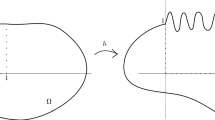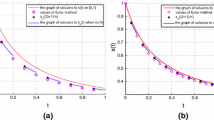Abstract
The classical theorems about singular perturbation reduction (due to Tikhonov and Fenichel) are concerned with convergence on a compact time interval (in slow time) as a small parameter approaches zero. For unbounded time intervals Hoppensteadt gave a convergence theorem, but his criteria are generally not easy to apply to concrete given systems. We state and prove a convergence result for autonomous systems on unbounded time intervals which relies on criteria that are relatively easy to verify, in particular for the case of a one-dimensional slow manifold. As for applications, we discuss several reaction equations from biochemistry.
Similar content being viewed by others
References
Amann, H.: Ordinary Differential Equations. An Introduction to Nonlinear Analysis. Walter de Gruyter, Berlin (1990)
Back, J., Shim, H.: Adding robustness to nominal output-feedback controllers for uncertain nonlinear systems: a nonlinear version of disturbance observer. Automatica 44, 2528–2537 (2008)
Briggs, G.E., Haldane, J.B.S.: A note on the kinetics of enzyme action. Biochem. J. 19, 338–339 (1925)
Cavallo, A., Natale, C.: Output feedback control based on a high-order sliding manifold approach. IEEE Trans. Autom. Control 48, 469–472 (2003)
Feinberg, M.: The existence and uniqueness of steady states for a class of chemical reaction networks. Arch. Ration. Mech. Anal. 132, 311–370 (1995)
Fenichel, N.: Geometric singular perturbation theory for ordinary differential equations. J. Differ. Equ. 31, 53–98 (1979)
Gantmacher, F.R.: Applications of the Theory of Matrices. Dover Publication, Mineola (2005)
Goeke, A., Schilli, C., Walcher, S., Zerz, E.: Computing quasi-steady state reductions. J. Math. Chem. 50, 1495–1513 (2012)
Goeke, A., Walcher, S.: A constructive approach to quasi-steady state reductions. J. Math. Chem. 52, 2596–2626 (2014)
Goeke, A., Walcher, S., Zerz, E.: Determining “small parameters” for quasi-steady state. J. Differ. Equ. 259, 1149–1180 (2015)
Hirsch, M.W.: Differential Topology. Springer, New York (1976)
Horn, F., Jackson, R.: General mass action kinetics. Arch. Ration. Mech. Anal. 47, 8–116 (1972)
Hoppensteadt, F.C.: Singular Perturbations on the Infinite Interval. Trans. Am. Math. Soc. 123, 521–535 (1966)
Keener, J., Sneyd, J.: Mathematical Physiology I: Cellular Physiology, 2nd edn. Springer, New York (2009)
Lax, C.: Analyse und asymptotische Analyse von Kompartimentsystemen. Doctoral dissertation, RWTH Aachen (2016)
Michaelis, L., Menten, M.L.: Die Kinetik der Invertinwirkung. Biochem. Z. 49, 333–369 (1913)
Milnor, J.W.: Topology from the Differentiable Viewpoint. Princeton University Press, Princeton (1997)
Nestruev, J.: Smooth Manifolds and Observables. Springer, New York (2003)
Noethen, L., Walcher, S.: Tikhonov’s theorem and quasi-steady state. Discrete Contin. Dyn. Syst. Ser. B 16, 945–961 (2011)
Segel, L.A., Slemrod, M.: The quasi-steady-state assumption: a case study in perturbation. SIAM Rev. 31, 446–477 (1989)
Seliger, K.: Singuläre Störungen auf unbeschränkten Intervallen. Master’s thesis, RWTH Aachen (2015)
Stiefenhofer, M.: Quasi-steady-state approximation for chemical reaction networks. J. Math. Biol. 36, 593–609 (1998)
Teel, A.R., Moreau, L., Nesic, D.: A unified framework for input-to-state-stability in systems with two time scales. IEEE Trans. Autom. Control 48, 1526–1544 (2003)
Tikhonov, A.N.: Systems of differential equations containing a small parameter multiplying the derivative. Math. Sb. 31, 575–586 (1952). (in Russian)
Walter, W.: Ordinary Differential Equations. Springer, New York (1998)
Acknowledgements
We thank an anonymous reviewer for helpful detailed comments. The first author acknowledges support by the DFG Research Training Group “Experimental and constructive algebra”.
Author information
Authors and Affiliations
Corresponding author
Appendix: Hoppensteadt’s Conditions
Appendix: Hoppensteadt’s Conditions
For the reader’s convenience we recall here the conditions and the main result from Hoppensteadt’s original paper [13]. Recall the notation \(S_R\) from (2.3). Hoppensteadt considers a non-autonomous system that is given in Tikhonov standard form
with f and g defined on an open set
which satisfies \(S_R\subseteq D\) for some \(R>0\), and \(f,\,g\) having values in \({\mathbb {R}}^s\) and \({\mathbb {R}}^r\), respectively. Assume that the following conditions hold:
-
(I)
The system
$$\begin{aligned} y_1'&=f(\tau ,y_1,y_2,0) \end{aligned}$$(5.3)$$\begin{aligned} 0&=g(\tau ,y_1,y_2,0) \end{aligned}$$(5.4)admits a solution \(Y:\,[0,\infty )\rightarrow {\mathbb {R}}^{s+r}\), \(\tau \mapsto Y(\tau )\). With a suitable transformation of (5.3)–(5.4) one may assume that \({\widetilde{Y}}\equiv 0\) is a solution of the transformed system. From here on, it will be assumed that (5.3)–(5.4) admits the solution \({\widetilde{Y}}\equiv 0\).
-
(II)
The functions f, g and their partial derivatives with respect to \(\tau \), \(y_1\), \(y_2\) respectively satisfy
$$\begin{aligned} f,g,D_1f,D_2f,\partial _{\tau }g,D_1g,D_2g \in C([0,\infty )\times S_R\times [0,\varepsilon _0]). \end{aligned}$$ -
(III)
There exists an isolated and bounded \(C^2\)-solution \(Y_2=Y_2(\tau ,y_1)\) of the implicit equation
$$\begin{aligned} g(\tau ,y_1,Y_2(\tau ,y_1),0)=0 \end{aligned}$$for all \(\tau \in [0,\infty )\) and \(y_1\in S_1\). By a transformation \({\widetilde{y}}_1=y_1\) and \({\widetilde{y}}_2+Y(\tau ,y_1)=y_2\), one may obtain that \(Y_2(\tau ,{\widetilde{y}}_1)=0\) for all \((\tau ,{\widetilde{y}}_1)\in [0,\infty )\times S_1\). This will be assumed for the original system (5.1)–(5.2) in the following.
-
(IV)
\(f(\cdot ,\cdot ,0,0)\) is uniformly continuous in \([0,\infty )\times S_{1,R}\), and moreover \(f(\cdot ,\cdot ,0,0)\) and \(D_1f(\cdot ,\cdot ,0,0)\) are bounded in \([0,\infty )\times S_{1,R}\).
-
(V)
\(g(\cdot ,\cdot ,\cdot ,0)\) is uniformly continuous in \([0,\infty )\times S_R\), and moreover \(g(\cdot ,\cdot ,\cdot ,0)\), \(\partial _{\tau }g(\cdot ,\cdot ,\cdot ,0)\), \(D_1g(\cdot ,\cdot ,\cdot ,0)\) \(D_2g(\cdot ,\cdot ,\cdot ,0)\) are bounded in \([0,\infty )\times S_R\).
-
(VI)
The solution \({\widetilde{Y}}\equiv 0\) of
$$\begin{aligned} y'=f(\tau ,y,0,0) \end{aligned}$$(5.5)is uniformly asymptotically stable in the following sense: There exist a continuous, strictly increasing function
$$\begin{aligned} d:[0,\infty )\rightarrow [0,\infty )\quad \text {with }d(0)=0 \end{aligned}$$and a continuous, strictly decreasing function \(\sigma :[0,\infty )\rightarrow [0,\infty )\) with \(\lim _{s\rightarrow \infty }\sigma (s)=0\), such that for every solution \(\Phi (\tau ,z)\) of (5.5) with initial value \(y_1(0)=z\in S_{1,R}\) and all \(\tau \ge 0\) one has
$$\begin{aligned} \left| \Phi (\tau ,z)\right| _1\le d(\left| z\right| _1)\cdot \sigma (\tau ). \end{aligned}$$ -
(VII)
For all \((\alpha ,\beta )\in [0,\infty )\times S_{1,R}\) the solution \({\widetilde{Y}}\equiv 0\) of
$$\begin{aligned} {\dot{x}}=g(\alpha ,\beta ,x,0) \end{aligned}$$is uniformly asymptotically stable in the following sense: There exist a continuous, strictly increasing function
$$\begin{aligned} e:[0,\infty )\rightarrow [0,\infty )\quad \text {with }e(0)=0 \end{aligned}$$and a continuous, strictly decreasing function \(\rho :[0,\infty )\rightarrow [0,\infty )\) with \(\lim _{s\rightarrow \infty }\rho (s)=0\), such that for every solution \(\Psi (t,x_{0};\alpha ,\beta )\) of the equation with initial value \(x(0)=x_{0}\in S_{2,R}\) and parameters \((\alpha ,\beta )\in [0,\infty )\times S_{1,R}\) and all \(t\ge 0\) one has
$$\begin{aligned} \left| \Psi (t,x_0;\alpha ,\beta )\right| _1\le e(\left| x_0\right| _1)\cdot \rho (t). \end{aligned}$$
Given these assumptions, Hoppensteadt’s main result [13] can be stated as follows:
Theorem 5.1
There exists a compact neighborhood \(K\subset S_R\) of 0 and \(\varepsilon _0^*\in (0,\varepsilon _0)\) such that the solution \(\Phi (t,y_0,\varepsilon )\) of (5.1)–(5.2) with initial value \(y(0)=y_0:=(y_{1,0},y_{2,0})\in K\) at \(\tau =0\) exists for all positive times provided that \(0<\varepsilon <\varepsilon _0^*\). Moreover \(\Phi (t,y_0,\varepsilon )\) converges uniformly on all closed subsets of \((0,\infty )\) towards the solution of (5.3)–(5.4) with initial value \(y_1(0)=y_{1,0}\), as \(\varepsilon \rightarrow 0\).
Rights and permissions
About this article
Cite this article
Lax, C., Seliger, K. & Walcher, S. A Coordinate-Independent Version of Hoppensteadt’s Convergence Theorem. Qual. Theory Dyn. Syst. 17, 7–28 (2018). https://doi.org/10.1007/s12346-017-0235-2
Received:
Accepted:
Published:
Issue Date:
DOI: https://doi.org/10.1007/s12346-017-0235-2




